Thursday, September 17, 2009
It’s a clear, sunny morning in Chicago and the freeways outside our hotel window are crowded with people on their way to work. We’re here for the day as we get ready to board a plane for Manchester, England tonight. From Manchester, we’ll take a bus less than an hour to the town of Stoke-on-Trent, where we’ll begin our first-ever narrowboat “holiday” as the British refer to their vacations.
What’s a narrowboat?
That’s the question we asked Chuck and Joni, a couple that we’ve become friends with since they moved to Hobbs a few years ago. Joni is the mother of one of our longtime friends and she and Chuck have traveled all over the world and taken thousands of photographs of their journeys.
As it happened, we only learned about narrowboats through what Cindy refers to as my “collecting disease”. During the years we’ve been together, I’ve cluttered shelves, cabinets and the attic with various items I’ve collected, from tube radios to tiki mugs.
A few years back, when Chuck and Joni were packing up for their move to Hobbs, they sent me a big stack of cardboard beer mats they had collected while traveling in Germany.
Instant collection!
A few months later, we were having dinner with Chuck and Joni and were looking through a photo album with pictures of their Germany trip. We noticed some pictures of long, colorfully-painted boats, which they explained were from their narrowboat trip through the heart of England. My curiosity was sparked.
Narrowboats are long boats, and as their name implies, relatively narrow. The boats are built to travel on the network of thousands of miles of canals that wind through the countryside of England, Scotland and Wales. The beginning of the canal system dates to the 1700’s when boats on the canals were used to transport coal and other staples in the days before the railroad. The canals are also sometimes referred to as “the cut”.
Since England isn’t flat, the canals have a system of locks to compensate for changes in elevation. Some of these locks are only 7 feet wide, which means that any boats that use them must be less than 7 feet wide; thus the term narrowboat.
Over the past few decades there has been a growing interest by vacationers in spending time aboard a narrowboat, and at present there are dozens of narrowboat rental companies with bases at various locations on the canals.
With thousands of miles of canals, the possibilities when selecting a route to travel are endless. We ended up picking our route, on the Caldon Canal, technically a branch of the Trent & Mersey Canal, because of the scenery and the number of pubs along the way. Our intention is to do very little cooking on the boat and we’ve planned our itinerary to put us close to a recommended pub each evening so we can sample the local brew and food and then walk back to our boat and bed down for the night.
The narrowboats for rent (or “hire” as the British say) today are nothing like the working boats of yesteryear. Most resemble a motorhome inside, with bedrooms, bath, kitchen and dining areas, albeit compact. Since they must be less than 7 feet wide, the boats need to be long to fit all of that in. In the case of the boat we will rent this week, it will be 58 feet long and sleep six. It will have two bathrooms, one of them containing a small shower. The boat is piloted from the rear, with the “captain” standing on a platform and looking over the roof of the boat and operating a tiller and power control.
We’ll pilot our narrowboat ourselves and will also operate the locks we come to along the way, raising or lowering the water level in them to raise or lower our boat to match the water level in the stretch of canal that lies ahead. We’ll also operate a few lift-bridges that will lie in our path. It should be an interesting and challenging week.
With all morning to kill in Chicago before our flight, Jack called his cousin Ann who lives nearby and she picked us up for breakfast in nearby Park Ridge, Illinois. Afterwards Ann came back up to our hotel room and Jeannie showed her pictures of our Germany trip. Ann recognized the area along the Rhine River and we discovered that back in the 1980’s Ann stayed in the same small village of Bacharach that we recently did.
Friday, September 18, 2009
We’re sitting at the Manchester, England airport waiting the two hours from the time of our arrival until our bus to Stoke-on-Trent leaves. Our overnight flight from Chicago took 7 hours, but we lost 6 hours from time zone changes, so we’re all a little groggy after grabbing just a few hours sleep on the plane. The temperature here, in the 50’s at 8:20 in the morning, feels cold relative to where we’ve come from. Back home we were wearing shorts and sandals a couple of days ago, but here we’re digging in our suitcase for our Polartec jackets.
We use the ATM to get some local currency and it’s all I can do to resist stashing some of the newer bills in a secret compartment of the suitcase for my small foreign currency collection back home. (It really is like a disease, you know.)
After killing a couple of hours in the bus terminal next to the airport, we boarded our bus to the bus station in Stoke-on-Trent, where we got a cab to the Best Western Moat House.
We spent a lot of the rest of the day walking, going from our hotel down to the marina where we would pick up our boat the next day. Next, we decided to walk to the grocery store we planned to use to pickup food for the week, which turned out to be about half a mile further away than Google Maps had placed it.
Since we were buying items that needed refrigeration, we didn’t buy anything yet. Then, we walked back to hotel to rest for a bit before walking back to marina, to eat at the Toby Carvery there.
We discovered that the hardest part about walking around in the city in the UK is learning to look the other way when crossing the street, since they drive on the other side of the road over there.
Saturday, September 19, 2009
We had breakfast at our hotel and then rolled our luggage along the sidewalk the quarter mile to Black Prince Narrowboats offices at the marina. Leaving our luggage there, we walked to grocery store, where we learned about their method of keeping up with their grocery carts.
All of the store’s carts are stored chained together by a little device on each cart that accepts 1 pound coins to release it. So, you walk up to the carts, dig out a 1 pound coin (about $1.60) and feed it into the device, remove your cart and do your shopping. When you’re through, you retrieve your coin by returning the cart to where you got it and chaining it back to the rest of the carts there.
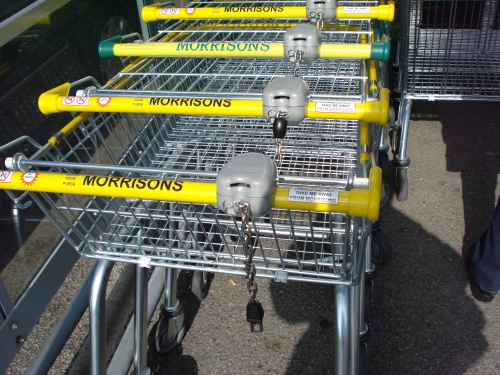
Shopping carts at Morrison's in Stoke-on-Trent
Morrison’s was packed with people and Jack, who managed grocery stores in Arizona for years, said that he had never had a store as busy as this one. And, there was lots of traffic in Stoke-on-Trent too. Lots of compact yet attractive automobile models that aren’t even sold in the U.S. There may have been a recession on, but people were very busy scurrying about.
Once we’d completed our shopping, we called a cab to transport us and our groceries back to the marina, where we loaded them onto the boat. Chris, one of the Black Prince employees showed us around the boat and pointed out the various features and told us what we’d need to do to keep it operating.
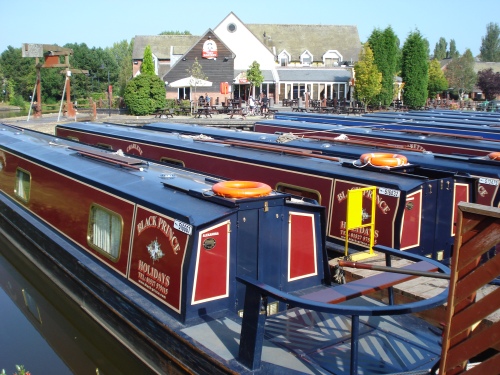

Another employee was assigned to ride with us down to the first lock in our journey, to show us how to operate the lock and pilot the boat through it. Since the boat was pointed the opposite direction from where we intended to go, he turned it around (or “winded”) in front of Black Prince’s boatyard and then handed the tiller over to me.
Just a couple of minutes later, as I tried to get the handle on steering this 58-foot monster from the back end, I seemed to lose power and steering at the same time. Our guide tried the controls and announced that we probably had something stuck in the propeller. We were in the middle of a wide turn, but he managed to get the boat maneuvered to the edge of the canal and tied up to a steel fence there. Then, he opened the engine compartment and climbed down to remove the weed hatch, a metal plate just above the propeller. He reached down into the water in the weed hatch opening, which was about 8 inches by 18 inches and said it felt like a piece of carpet. He struggled a few minutes and pulled and sure enough, pulled up a piece of beige carpet through the weed hatch. He kept pulling, and the carpet kept coming.
By the time he finished, he had pulled a piece of carpet through the weed hatch, into the engine compartment that would have covered the floor nicely in a small bathroom. He threw it into the grass beside the canal and I later wondered how long it would be before some bored teenager would come along and throw it back into the canal.
The locks we would encounter along our route all worked much the same way, with a few variations. The basic premise is that the water on either side of the lock is at different levels. The lock is used to move our boat from one level to the next, which may either up or down, depending on what direction we’re traveling.
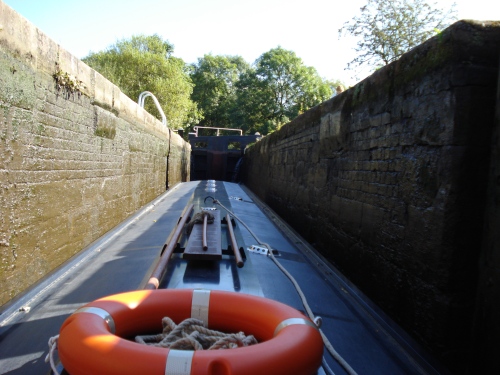
The view from the driver's position at the back of the boat sitting in a lock where the water level has been lowered.
If there are no boats coming in the opposite direction, we (and by “we” I mean Jeannie and Jack who did most of the lock operation) check to see if the water is at the same level as our boat. If it is, we simply open the gate and drive the boat into the lock, close the gate and then raise or lower the water to match the water on the other side of the lock, open the gate at the other end and navigate out.
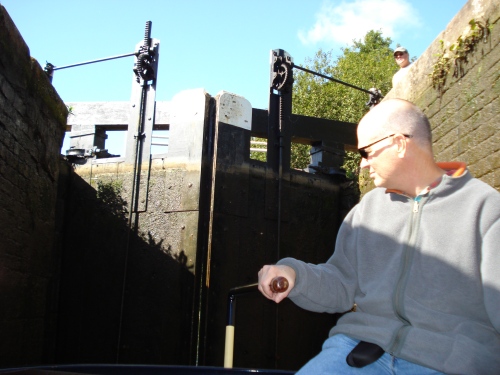
Sitting in an empty lock waiting for the water level to be raised. The water mark on the gates behind me show how much it will rise.
If the water wasn’t at the same level as our boat was, we would open the “paddles” on the gates at the appropriate end of the lock to either let more water in or drain water out to adjust the level. Once this was done, the gates would be opened, the boat moved inside the lock, the gates closed, the water raised or lowered and the boat driven out the other gate. Sometimes, the change in elevation of the countryside is so dramatic that several locks are arranged in close proximity, one after another.
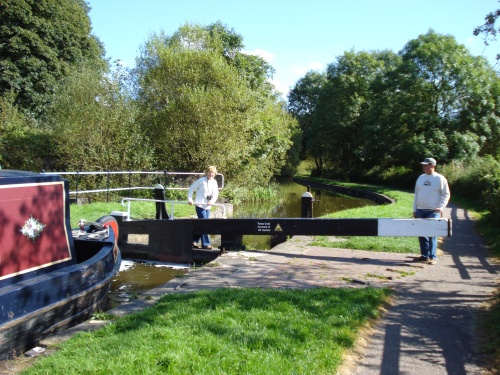
With the boat sitting in a lock they've just filled, Jeannie and Jack prepare to open the gate so we can proceed down the canal.
We only passed a couple of moored boats on our first day, before mooring for the night ourselves in Milton near Bridge #18 across the canal from some residences with beautifully landscaped yards leading down to the water. We were just a little over four miles from where we had started that day. We liked the location where we moored that night so much, we moored there again when we came back through going the other direction.

The beautifully landscaped canalside homes in Milton where we moored Saturday night and Wednesday night.
The narrowboat “Serena” passes us as we’re mooring and they moor up just past us. After driving stakes into the ground to tie up to and marking them with white plastic bags so walkers on the towpath won’t trip over them, we walk to the nearest bridge and up into the town of Milton.
We locate the Millrace pub but find no place to sit, so we decide to try to locate another pub on our map, the Miners Arms. Walking down a residential street where we think it might be located, a lady steps out onto her front porch to inform us that we’re about to step onto private property. We explain what we’re looking for and she tells us we’d be much better off at The Foxley, another local pub. She gives us directions and we set off for it. But, at the Foxley, we learn that they don’t serve food, so we’re forced to head back to the Millrace. By now a table has opened up and we sit down to dinner of fish & chips and beer. As it turns out, the couple sitting at the table next to us are from “Serena” the boat that will be our neighbor for the night, and we had a nice chat with them.
Sunday, September 20, 2009
Today we traveled a little over five miles, stopping to refill our water tank at Park Lane Bridge (#31) and mooring just beyond the Holly Bush pub on the Froghall branch of the Caldon Canal. After mooring, we walked to the Holly Bush and sat outside with a good-sized crowd of dogs and their owners for what appeared to be a regularly scheduled doggie happy-hour. All of the dogs (and owners) were well-behaved and the food and beer were good.
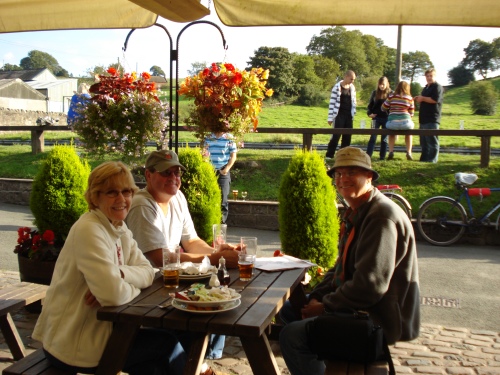
Monday, September 21, 2009
We continued on the Froghall branch, with Jack taking the helm for a while and catching his own piece of carpet in the propeller, although not nearly as large as my own prize. Jack opened the weed hatch and fished it out and we continued onward. But by now, I was sure every time the tiller felt a little funny that it was due to another piece of carpet on the propeller, so we stopped twice more with Jack checking the weed hatch and finding nothing.
It was about this time that we noticed that there was water standing in the bottom of the engine compartment a couple of inches deep. At a lock, we mentioned this to another boater named Steven who took a look and tried to advise us on what to do. We finally found the button for the bilge pump and pumped a pretty good amount of water out. Along we went, checking the water now and then and discovering more water accumulating, which we would then use the bilge pump to pump out.
You see all sorts of narrowboats on “the cut”, from old wooden contraptions badly in need of a paint job to modern, sleek dreamboats with satellite tv antennas looking like they just came off the showroom floor. It was one of these latter, perhaps the nicest boat we saw the entire week that would hold the honor of being the only boat we bumped into the whole week.
The thing about piloting a narrowboat is that the steering is entirely reliant on applying power to the propellers. The tiller controls which way the propellers point, but if the engine is in neutral moving the tiller does next to nothing. So, one’s natural panic-filled reaction when headed directly towards another boat, especially a really nice-looking expensive boat, to cut the power to the propeller, is exactly the wrong way to avoid a collision.
It was only a tiny bump. Really. But all you can do is yell “Sorry!” or “Sorry there, mate!” if you want to try to blend in, and sheepishly continue on past them. I hoped we wouldn’t run into (literally or figuratively) the people on this boat again during the days ahead. I had visions of being publicly ridiculed in a pub full of rowdy ale-swilling boat pilots.

We stopped at Cheddleton to walk up the hill in search of postcard stamps, bottled water and lunch, which was “take-away” fish & chips eaten sitting on a low block wall outside the tiny restaurant.
More dog encounters as we came upon the small post office. Just outside the door there was a ring for tying up one’s dog while taking care of business inside. When we arrived, the tie-up was occupied by a couple of dogs waiting for their owner. A young woman with a dog of her own arrived about the same time we did and appeared to be prepared to wait until the doggie tie-up ring was free, so Jack volunteered to hold her dog while she went inside. Jack and the dog were best buddies by the time the postal business was done.
After getting back to the boat, we continued on toward Froghall, but decided to wind (turn around) at Flint Mill Lock, about a mile and a half short of Froghall. This allowed us plenty of time to moor for the night close to the Black Lion pub.
The Black Lion sits relatively close to where the Caldon Canal splits in two, with one branch going to Froghall and the other to Leek. It’s a beautiful location, with railroad tracks running in front of it and tables outside and inside. We opted to sit outside and were surprised to see Steven, who we had consulted with about our leak earlier in the day, and the rest of his family, wife Lynn, father-in-law Bob and mother-in-law Dalene. Bob immediately invited us to have a drink with them and bought the first round of beers. We had a great time visiting with them about cats, dogs, narrowboating and such, with Jack buying the next round before they moved inside for dinner.
While we were talking to Bob and his family, another familiar couple arrived at the Black Lion and sat down at the table next to ours: the couple in the really nice boat we had bumped earlier in the day. We whispered among ourselves that we really should go over and introduce ourselves, but we failed to do so before the fancy boat’s pilot did so himself. He turned out to be another friendly and helpful boater, like so many we met during the week.
Tuesday, September 22, 2009
After lying awake half the night worrying that our leak might continue and we could wake up seriously underwater, we decided to call Black Prince to ask what to do. They said they would send someone to meet us at Cheddleton, where we were headed that morning.
We moored at Cheddleton and waited for someone from Black Prince to arrive. When we were tying up there, Michelle Martin, an artist who lives on her boat and paints portraits helped us figure out how to use the mooring posts provided where we were mooring. Everyone we met along the way was more that willing to help out inexperienced boaters.
While we waited, we walked around the carefully preserved old railway station for the Churnet Valley Railway next to the canal.
After a short wait, a mechanic from Black Prince arrived and opened the engine compartment. Within about two minutes he had deduced that a valve from the hot water heater was sending water to a drain hose that ended in the engine compartment. He closed the valve and told us we should have no more problem with water in the engine compartment.
We continued on, making the turn onto the Leek branch of the Caldon Canal. Along the way, we met Bob, Steven, Lynn and Dalene in their boat headed the opposite direction. As we passed, Bob popped out of the front cabin holding two pint bottles of Marston’s Pedigree, an ale brewed not far from the area, which he indicated he was going to pitch to us. We were moving too fast for him to throw both of them, but Jack did manage to catch one, which we enjoyed later that night.
We had planned on mooring for the night at the winding hole before the 130 yard tunnel outside of Leek and were pleasantly surprised to find the “winding hole” was more like a small lake. We tied up and walked into town in search of a grocery store.
We’d seen a Morrison’s grocery store on the map in Leek, but didn’t know exactly where it was. After walking down one of Leek’s main streets for quite a distance, we were just about to give up and turn back for the boat when Cindy asked a woman walking a large dog for directions. Nita, and her dog Blue didn’t just give us directions, they actually walked us the mile or so from where we were to the grocery store. And then, before turning us loose, Nita gave us careful directions for a shortcut back to the canal and, worried that we might get lost, even wrote down her telephone number and urged us to call if we had any problem at all.
We bought freshly baked meat pies in the bakery section at Morrison’s and carried them back to our boat, enjoying dinner and a nice ale provided by our British friends on the water that night.
Wednesday, September 23, 2009
We turned around and headed back the direction we had come, stopping to get water again at Park Lane Bridge (#31), and just in time as Jeannie almost ran out of water during her shower. We had more of the delicious meat pies from Morrison’s for a late lunch and then moored across from the nicely-landscaped homes at Milton where we had on Saturday night.
We walked around town in the afternoon and then had dinner at the Millrace again for another great meal. The most expensive thing on the Millrace’s menu was 4.50 pounds, which would be a little over $7.00.
Thursday, September 24, 2009
We probably covered the greatest distance of the entire trip on Thursday, starting at Milton on the Caldon Canal and mooring just before Bridge 104 near the Wedgwood factory on the Trent & Mersey. Along the way we stopped for water at Etruria Junction, turned the corner onto the Trent & Mersey Canal, had to wait in line behind several boats for the flight of locks just south of the junction and still moored in time for Jeannie and Cindy to make it to the Wedgwood Visitor Centre in time to get in 30 minutes of shopping before they closed.
We walked to the Plume of Feathers in nearby Barlaston for dinner, meeting along the way a woman on a scooter out walking three of her dogs and stopping to visit with the other boaters moored near us.
Inside the Plume of Feathers, we ran into a mother and daughter we had met earlier in the day as we waited in line to go through the flight of locks at Stoke. They were making their annual narrowboat trip alone, the father having declined to come along this year. We had a nice visit with them and finished the evening with two more British friends added to our growing list.
Friday, September 25, 2009
After getting up fairly early, Jack and I walked down beyond Bridge 104 to try to figure out if the wide spot we had seen walking to the pub the night before really was the winding hole. I’d been worried about it since seeing it, because we needed to get turned around and be on our way back to the Black Prince boatyard early enough to allow for any delays on the flight of locks that lay between here and there.
A seasoned boater was standing on the stern of his boat next to the wide place having a morning smoke, so we asked if this were indeed the winding hole. Sure enough, it was. He told us we’d make it with no problem in our 58-footer, that even 70-foot boats could wind there. There were two boats moored close to either side of the spot, and he pointed out that they really shouldn’t be that close. We ended up turning around just fine, after a little forward and reversing (and waking up one of the people who was parked a little too close and got their boat rocked by all the water we were moving around).
With the winding done, we had a nice leisurely ride back up to the Black Prince boatyard, with Jack taking the controls for the day, giving me my first chance to operate the locks.
Along the way, we stopped beside an old cemetery and Jeannie and Jack walked around and looked at the headstones, some of which were a couple hundred years old. We didn’t have to wait in line at any of the locks on the way back, although we did have to empty them since other boats going our same direction had just used them. There was very little traffic either direction on our final day. We moored outside the Black Prince yard, where we had picked up Charlene six days earlier, and took a cab to the Hanley bus station to wait for our bus to Manchester. Our cab driver pointed out that Jack closely resembled Fabio Capello, the manager of the English National Football Team.
At the bus station, Jack and I sat with the luggage and for the first time all week were finally able to open the books we’d planned to read, while Cindy and Jeannie walked around and shopped in the nearby streets.
There was an earlier bus to Manchester, which arrived at the station almost at the same time our bus was scheduled to arrive, so we asked the driver if he had room for us. He told us to hop on, and commented that the traffic was terrible. We figured there must have been some congestion on the main highway leading between Stoke-on-Trent and Manchester, because our driver took backroads and city streets for the entire route. It was interesting though to see more than just the countryside bordering the highway that we’d seen on the bus ride down.
There were a couple of twenty-something guys sitting in front of us who were from Ireland and offered their opinion that “Britain is shit compared to Ireland”. They also were interested in purchasing one of the beers that Jack was carrying in a cooler-bag, but we insisted we would be needing them all later on.
I wish we had started making a list of pub names earlier in the week. We only saw a few on the canal, since we didn’t venture very far into the towns, but we saw a lot on that ride to the airport. Waggon & Horses (spelled with two “G”s), Crown & Anchor. Bleeding Wolf. King’s Arms. Several different Red Lions.
After arriving at the bus station at the Manchester Airport we took a cab to the Marriott Manchester Airport, which was the only airport hotel we could find with two queen beds in a room. On the way the cab driver filled us in on the Pittsburgh G20 Summit and Obama’s ultimatum for Iran.
As it turned out, the hotel only had a few of the two-bed type of room, and ours was located a floor below the main floor. The layout of the hotel was complicated and the route from registration to our room confusing, so we had to enlist the help of at least three on the hotel staff before someone finally knew where it was.
Friday night we dined on beer and fish & chips for a final time in one of the hotel’s restaurants. The music in the restaurant was an interesting mix of mostly songs we were familiar with, including artists like Van Morrison, The Eagles and Joe Cocker and was controlled by a DJ setup behind the bar. Shortly after the waiter stopped and talked to us, they played “Texas” by Chris Rhea. Did they recognize our accents, or was the song choice just a coincidence?
I wouldn’t be surprised if they played the song just for us, as every other person we had met during our trip went out of their way to be friendly and helpful. In doing my research on narrowboating, I kept running into the statement that the best thing about it was the people you meet along the way. And, after our week on the Caldon, I’ve got to say that it’s absolutely the truth. Everybody we met was friendly, enthusiastically helpful and curious about how we came to be there for our vacation.
If you’d like more information on narrowboats you might want to check out the links in an earlier post I made when I first became interested.

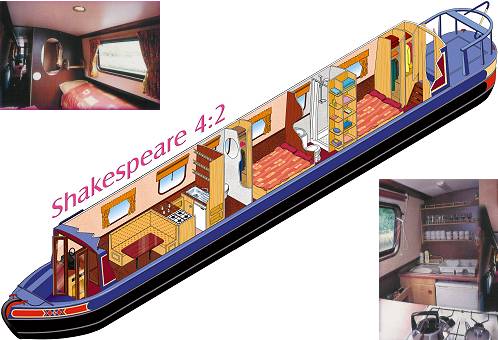
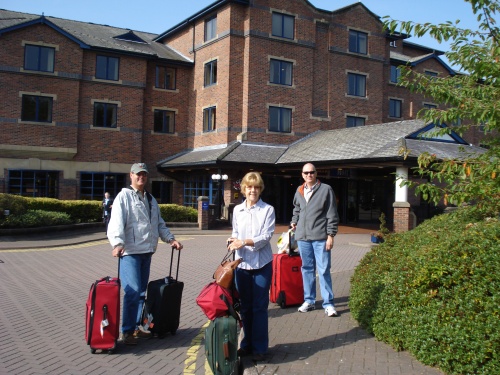



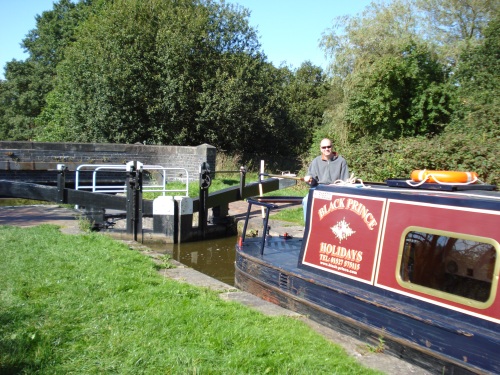
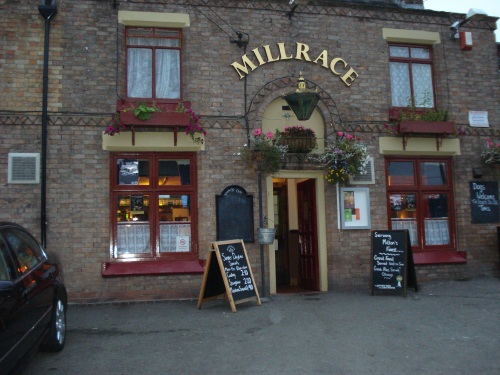

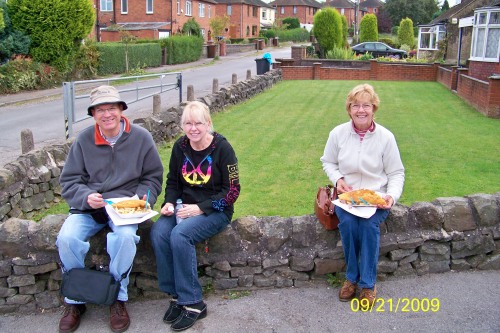

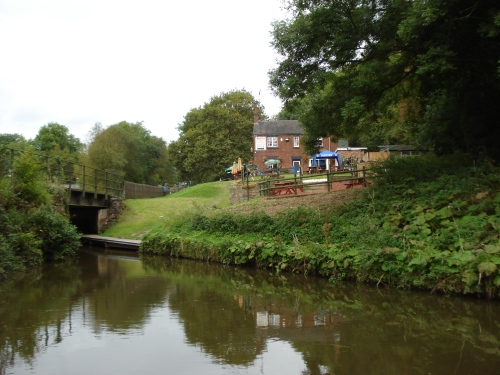

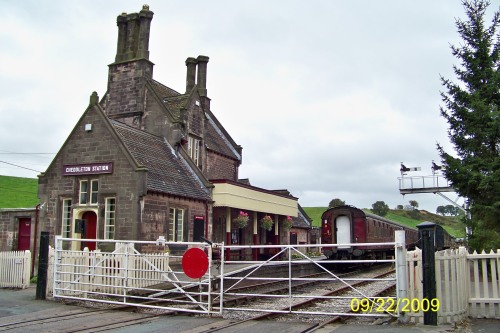
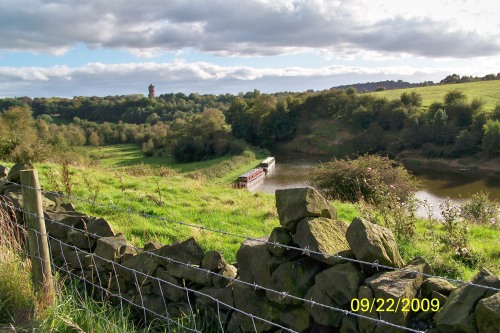
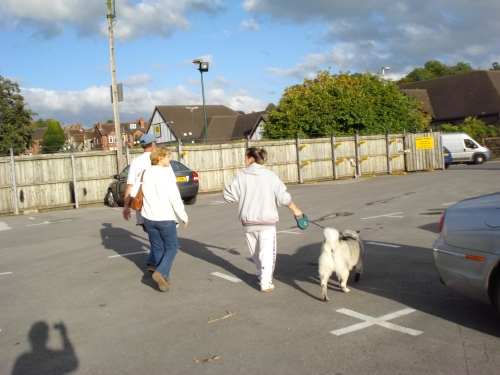
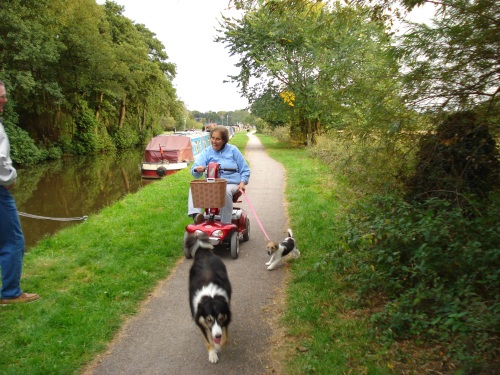

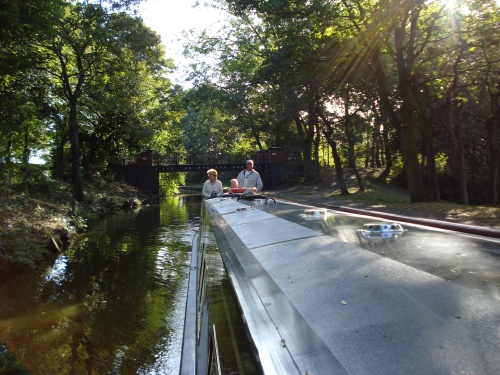
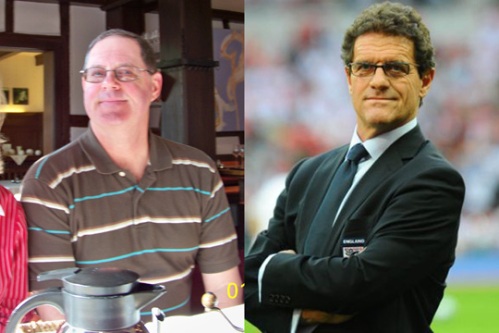
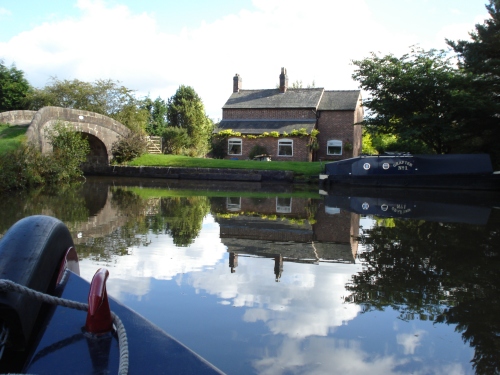

Mark and Cindy:
I absolutely LOVED your travel journey, and was so intrigued by the narrowboats!! Is this Jeannie Abbott with you???
Cindy, I met your friend, Kelly, here in Cloudcroft–such a nice man.
Firtsly I am very pleased that you enjoyed you canal holiday. We had two weeks on the canals starting from Black Prince, Etruria, Stoke-on-Trent from 1st August this year. I find your article to be very informative with excellent photographs. Thanks (Boats and Canals Forum)
Mark and Cindy, thanks so much for sharing your wonderful story and your trip pictures. I think Jack IS Fabio!
I’m must read more everyday. I loved the photo off Jack & Fabio….I really could not tell them apart.
I felt a part of the trip with the day to day diary.
Pleased that you had a great holiday. I was interested in your Caldon experience as I am hiring a boat in November and was considering a trip up the Caldon, although I understand the Frognall branch may be closed for out of season repairs.
Do you intend to have another narrowboat holiday?
Thank you for the wonderful account of your week on the cut. We are currently planning our third trip, having done the four counties ring (14 days in 08) and also a week from Evesham(Avon River) to Wooten Wawen in 06. Coming from Western Austalia we have nothing like the English canal system and as you have found it is the most wonderful way to travel.
We met you at the Etruria staircase locks! We were the bright green Canal Cruising nb, Alice Elizabeth. We went up to both Froghall and Leek, and were all agreed that it was a lovely trip, particularly after Stoke-on-Trent.
I’m glad you had such a good time. We were wondering how it had turned out for you. 🙂
(Followed the link from the canalworld forums)
What a lovely time you had, really pleased you had a good holiday.
I couldn’t think where I had bumped into you, but quickly realised when you said you had broke down at the Boat Inn Churnet Valley, it was only a brief meeting.
Thank you for putting me on your web page.
Churnet Valley is the best place to be in the world according to me, I love it because of the steam trains.
I love what you said about the Morrison’s trolleys it’s ace, you have called the trolleys carts, and you were amazed that you had to put money in to release them. Love it.
We just get used to all this and to be honest when I go shopping I hate it can’t wait to get back to my boat.
Best regards
Michelle Martin
Thanks for sharing your adventure in a narrowboat. It is something we are considering, an opportunity to meet up with my folks on a visit they may be taking to England next year. As their plans progress, so will ours, and I am always happy when the plan puts me on the water!